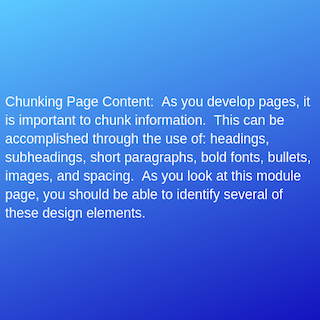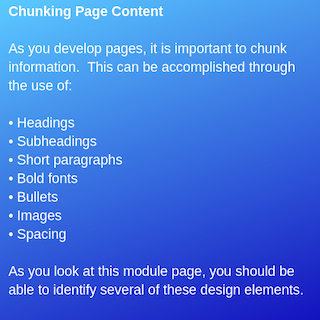Main Content
Chunking course materials means breaking down the presentation and pacing of your curriculum in a way that reduces the cognitive load on your students. Breaking your course materials into units, using formatting tools to make long documents more accessible, and using presentation techniques to convey importance are all a part of chunking your course materials.
Scaffolding is a similar concept addressing the pedagogy of your assignments and assessments: breaking them into smaller, cooperative pieces that provide opportunities for formative assessment and facilitate students achieving the learning goals you intend.
Both of these are naturally significant contributors to the pacing of your course.
Chunking
Chunking content is important in any learning environment. It allows students to engage with information in smaller, meaningful sections. We don’t want to cognitively overwhelm or overload students.
As you design your course, carefully consider the best way to chunk the material. Many instructors breakdown course content into weekly modules. That is what we have done in the UW Tacoma Online Template. If you have a course textbook, these modules may align with chapters or units from the book. A module can also be created to reflect weekly activities, topics, or major projects or course resources.
Often, modules will be further broken down into several pages and, possibly, external links, files, and so on. Each page will contain specific content related to one topic addressed in the learning module. Again, the purpose of chunking is to create manageable pieces of content.
For example:

Chunking Content on Individual Pages
As you develop pages, it is important to chunk information. This can be accomplished through the use of:
- Headings
- Subheadings
- Short paragraphs
- Bold fonts
- Bullets
- Images
- Spacing
As you look at the images below, which is easier to read and comprehend? The image on the left is just one long paragraph of text, while the image on the right shows text that is chunked into segments with more spacing:

|

|
Scaffolding
What is Scaffolding?
Scaffolding is a strategy used in education to help students reach their learning goals. Through peer collaboration and instructor support, students move from their current skillset to building an understanding of course content. Ideally, engagement with peers and the instructor helps the student develop skills he/she would not be able to acquire on their own. You should be intentional as you design your course with scaffolding strategies in mind. Here are a few suggestions:
Discussion Forums
- When using discussions, provide specific rules for interaction. Students should be required to read and respond to each other. After an initial post, set a minimum number of required responses to peers. Discussions allow students to share knowledge and build additional insight.
- Provide students with examples of excellent discussion postings. Also, consider modeling appropriate interactions. Students will observe how you interact and learn from it.
Projects/Research Papers
- Sometimes, students complete activities and you realize it wasn’t at all what you expected. This can happen in any course. To avoid these issues, large projects or papers should be broken into smaller pieces with due dates throughout the semester. This allows students to receive feedback and make adjustments as needed. It also encourages proper pacing of projects. Remember, exemplar work samples also scaffold learning.
Supplemental Resources
- Background knowledge varies from student to student. Some have taken related courses and gained valuable experience and knowledge. Others, especially in introductory level courses, may lack prior knowledge. As you design your course, keep in mind that all learners may benefit from a separate listing of supplemental resources. These resources provide additional insight for novice learners and enhance the learning experience for advanced learners.
Additional Resources
Pacing
The pace of your course is an important aspect in promoting student success. It should not feel too slow for students, resulting in boredom and decreased motivation. Likewise, it should not be too fast, leaving students feeling anxious and overwhelmed. In a traditional course, you read the expressions on students’ faces to determine when you need to speed up or slow down. You do not have that advantage in an online course.
Content, activities, and assessments will comprise your learning modules. Set a realistic goal for how much work can be completed in a week. Remember you are an expert in this area, your students are still developing their skills and may take longer than expected to complete activities. Also, remember additional time is needed to read responses and use technology tools.
Consider using a visual tool, such as a calendar, to help pace the course. Enter in due dates for activities and assessments. If there is too much overlap or too heavy of a workload, students will not be able to devote adequate time to each assignment. In addition, think about your role as the instructor. Will you be able to provide timely and specific feedback for all work?
Best practice in online course delivery is to have the entire class completed at the beginning of the quarter. This way students can see a big picture view of what they will be learning and can better plan for heavy weeks during the quarter. It allows for better time management and planning.
If you're not able to have the course 100% completed, you'll need to determine when modules will open for students to view. Keep this day consistent throughout the quarter and don't keep it a secret, Tell students when you will release content. If each new module opens on a Monday, with assignments due on Sunday, make sure you are available on the weekends to answer questions. If that schedule presents problems, consider opening new modules each Wednesday and having assignments due the following Tuesday. Students count on being able to work at a steady pace and depend on your consistency and availability.
